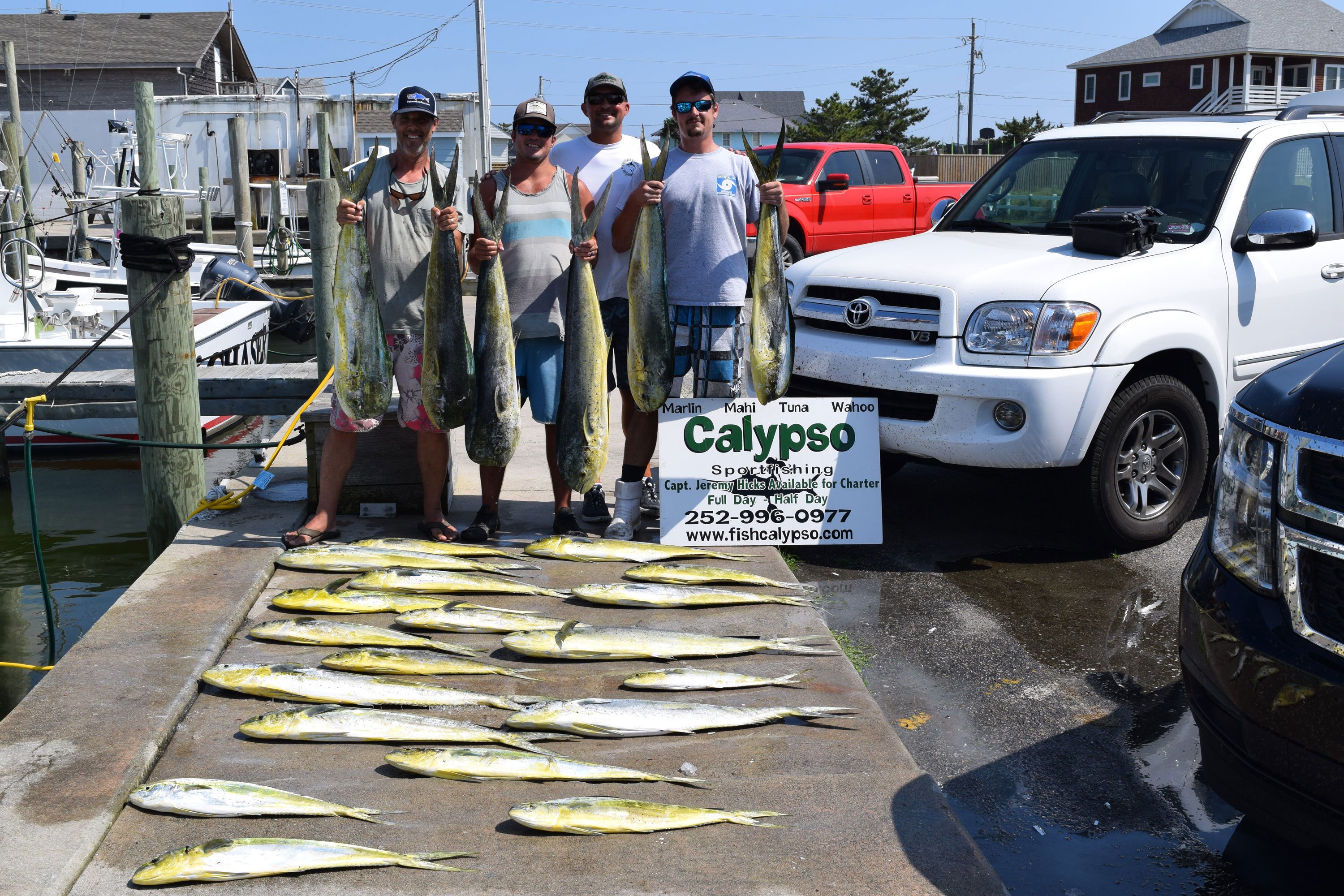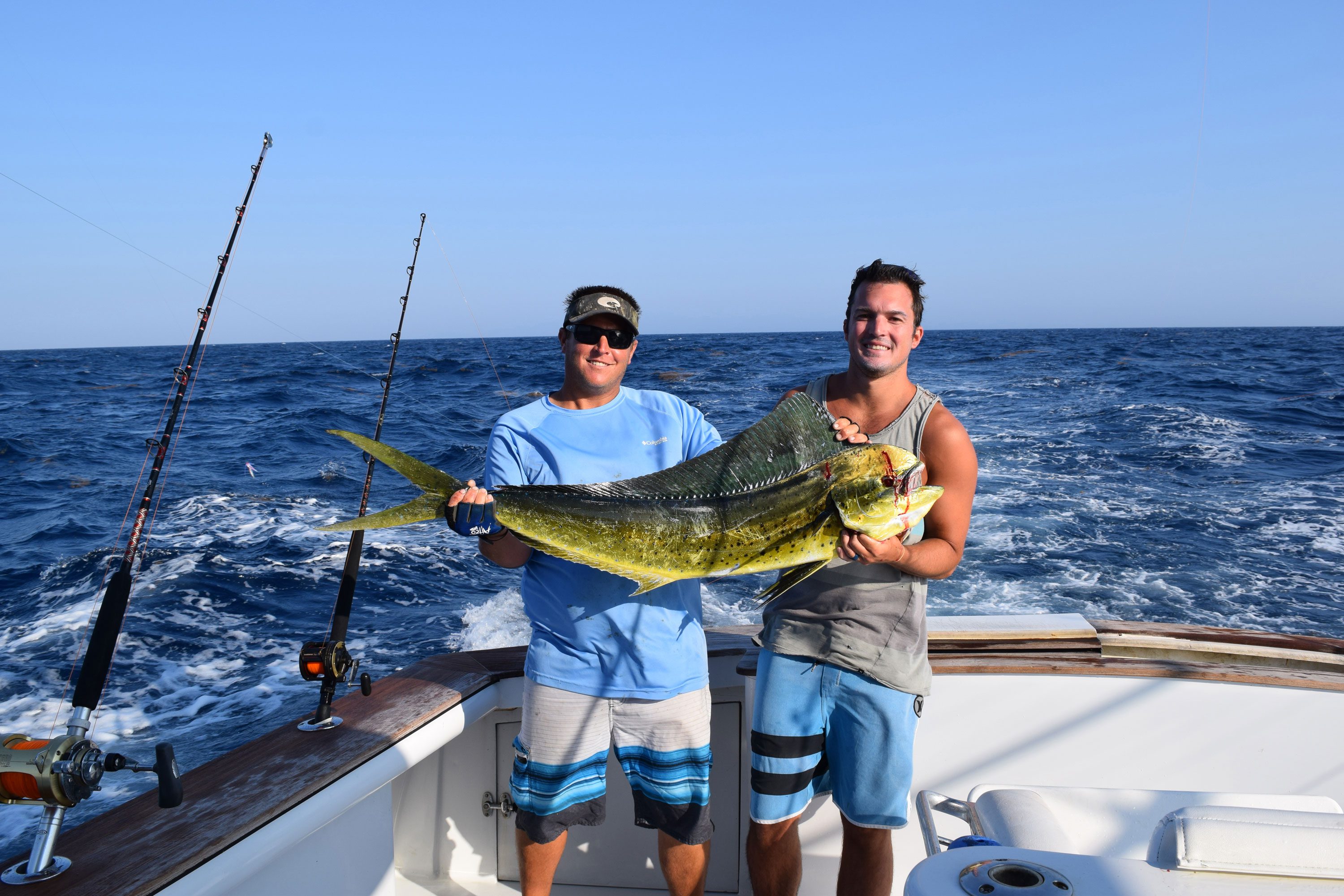Tidelines – June 6, 2019
The start of summer presents a great opportunity to head offshore in search of gaffer mahi, and Capt. Jeremy Hicks, of Calypso Sportfishing out of Hatteras Harbor Marina, was an easy choice to put some of the Fish Post staff on these hard-fighting, brilliantly-colored, great-tasting pelagics.
Jeremy had our party—me, writer Rocky Damico, and event worker Harris Brogden—headed out, via a new shortcut leading to the inlet, by 6:00 am, and it was just over an hour before Mate Jeffrey Kiefer deployed our spread at the 150 line in 40 fathoms.
The grass had been scattered for about a month now, and our day was no different. Jeffrey and Jeremy put out a full spread—flat lines, short riggers, long riggers, as well as shotgun lines and teasers—but it was quickly obvious that the grass was going to be relentless, so instead of trying to find a line to troll down, Jeremy made the decision to head through the barely-held-together grass lines to try and find a better edge further offshore.
We picked up a couple of quick mahi on our troll, one coming on a flat line and another on a short rigger as we passed a parking lot-sized mass of grass, but mostly the action in the back of the boat consisted of de-grassing. Trying to keep all the baits clean in so much grass was an impossibility, so Jeremy put Rocky on the right flat line and me on the left. Our job was to keep an eye on the flat line baits and clear them if they picked up grass, and that way Jeffrey could keep busy attending to all of the other details.
“It’s essential,” explained Jeremy, “to have my party stand by there to de-grass so the mate can do what he needs to do. I have the party stand by the dink baits, and I’m monitoring my baits.”
Most parties, he continued, like to be interactive on trolling trips, so having them de-grass is a win/win.
Another reason Jeremy had Rocky and I stand by the dink baits is because when it comes to summer mahi fishing, they tend to be the busiest baits.

Gary Hurley, Rocky Damico, Capt. Jeremy Hicks, and Harris Brogden with some of the mahi they caught on the charter boat Calypso out of Hatteras Harbor Marina.
“They are the most productive,” Jeremy explained while quickly reeling in a long shotgun line in hopes of clearing the ballyhoo. “The flat lines have split bills that swim real pretty. The split bill almost gives it a lip like a diving plug. They are also smaller baits, and these predator fish want to go after the easy kill.”
Jeremy’s typical mahi spread is dominated by naked ballyhoo, but also some skirted (pink and white as the favorite color).
We found our way to the outer edge, the better edge, of the scattered grass, and once we started down the line, the mahi action was steady. The fish going in the box were consistently in the 15-20 lb. class, and everyone was happy to be fighting fish instead of grass.
This outer edge of grass was in much deeper water, now at 107 fathoms, but still we were just 25 miles from the inlet. We were also in stronger current, facing into 3-4 knots, and that current had knocked down some of the wave and chop that had made for a bumpy ride out.
One of the joys of nonstop action on a summer mahi trip (in addition to the fillets that will fuel many a fish taco night), especially a trip with Jeremy and Jeffrey where they like to get their party as involved as they wish to be in the fishing action, is that you get to learn the routine and then practice and repeat the routine.
For example, a fish would hit the short rigger. Rocky would grab the rod, let the fish have the bait for 5-6 seconds, as instructed, so as to let the fish eat rather than just grab it, and then engage the drag to strike. Harris would move into position on the back of the boat and grab the Cush-It so that he could fight the mahi standing up instead of in the chair. I would bring down the popped rigger clip so that Jeffrey could more quickly put out a new bait as soon as the fish came to the gaff, and stand by to help clear lines, but more often than clearing lines I would hand rods over or under a crossed line.
Jeremy doesn’t want tangles, but he definitely wants to keep as many lines in the water as possible while bringing a hooked mahi in. He explained, “The more you have in the water, the better the chance you get a secondary or third bite. Only if there’s the risk of an inevitable tangle do you bring in that line. We’ve already had six or more fish hooked while we’re fighting a single fish in.”
We had our limit of mahi in the box by lunchtime, so we swapped out our mahi baits for bigger baits to try and raise a billfish. We heard on the radio that one boat had released a blue and another a sail, but after an hour or so with no billfish, we all decided it would be nice to get back to the docks a little early—Jeremy and Jeffrey to prepare for the next day, and Rocky, Harris, and I to start the drive back to Wilmington.

Rocky Damico (right) and mate Jeffrey Kiefer with one of the limit of gaffers brought in off the best edge of a scattered weed line. They were pulling rigged ballyhoo about 20 miles out of Hatteras Inlet with Capt. Jeremy Hicks on the charter boat Calypso.
Capt. Jeremy Hicks, of Calypso Sportfishing out of Hatteras, will be targeting mahi and billfish all summer long, and he’d love to put you on this popular and traditional Outer Banks summer pastime. You can find out more about Calypso by visiting www.fishcalypso.com, or if more convenient, then give Jeremy a call at (252) 996-0977.
Jeremy and Jeffrey will work hard to generate as much action as they can for you. You can decide for yourself how much you want to be involved in all parts of the process of bringing the fish in, but I suggest, perhaps more than any other task, that you leave the fish cleaning part of the process for the guys back at Hatteras Harbor Marina.
